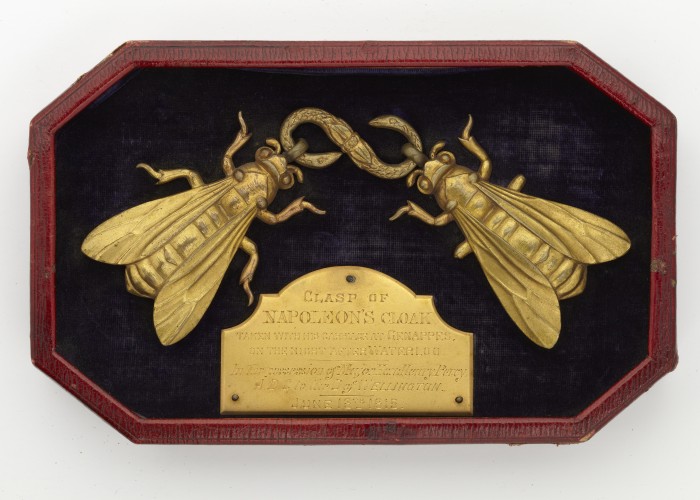Clasp from Napoleon’s Cloak
This cloak clasp, captured from the French during the Battle of Waterloo, is decorated with a design of two bees, joined by a central link. This was the personal emblem of Napoleon and a symbol of French imperial power. Whether the clasp was worn by the Emperor himself, or was a present to one of his close aides, its striking design is most definitely linked in some way to the charismatic leader.
The design of the clasp originates from 1804, and the beginning of Napoleon’s reign as Emperor of the French. Napoleon needed a new personal symbol for him and his family, to replace the fleur-de-lys of the deposed French Bourbon royal family. He chose the bee, which symbolised long life and hard work – appropriate given his almost boundless energy. It also linked Napoleon’s new royal house to the earliest French monarchs – a legendary story from 1653 claimed that golden bees had miraculously appeared in the tomb of Childeric I, whose son had united the Franks into the first kingdom of France in the 5th century. By using the bee, a symbol which pre-dated the fleur-de-lys, Napoleon demonstrated his belief in the legitimacy and perceived longevity of his regime.
Discarded during the retreat of the French army following the Batter of Waterloo, the clasp was discovered by the Honourable Major Henry Percy, aide-de-camp to the Duke of Wellington. Napoleon’s army had disintegrated, relentlessly pursued by the Prussian Army. Led by their Head of Staff August von Gneisenau, the Prussian soldiers showed little mercy towards the fleeing French troops. The French baggage train clogged up the roads, as the carts tried to negotiate the village of Genappe, the only crossing over the river Dyle.
The arrival of the Prussians in the town caused panic amongst the terrified French waggoners who abandoned their vehicles, forcing Napoleon to leave his carriage and flee on horseback. In the midst of this chaos Henry Percy found the Imperial baggage train, where he grabbed a cloak adorned with this golden clasp. He cut the clasp loose, taking it with him on his mission to deliver Wellington’s Waterloo dispatch back to London, carrying news of the Allied victory.
-
Curatorial info
- Originating Museum: Leven's Hall
- Material: Gold
-
Use this image
You can download and use the high resolution image for use in a non-profit environment such as a school or college, but please take note of the license type and rights holder information below
- Rights Holder: Copyright Leven's Hall. Photography Relic Imaging Ltd.
- License Type: Creative Commons
Find it here
This object is in the collection of Levens Hall






